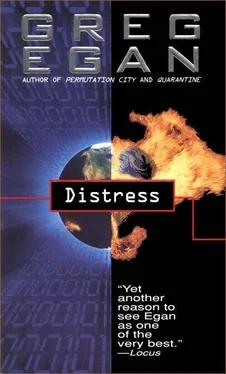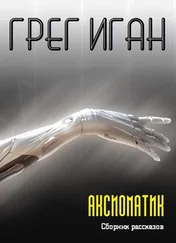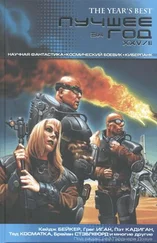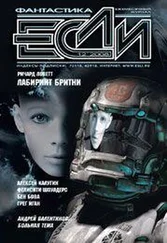Грег Иган - Distress
Здесь есть возможность читать онлайн «Грег Иган - Distress» весь текст электронной книги совершенно бесплатно (целиком полную версию без сокращений). В некоторых случаях можно слушать аудио, скачать через торрент в формате fb2 и присутствует краткое содержание. Жанр: Фантастика и фэнтези, на английском языке. Описание произведения, (предисловие) а так же отзывы посетителей доступны на портале библиотеки ЛибКат.
- Название:Distress
- Автор:
- Жанр:
- Год:неизвестен
- ISBN:нет данных
- Рейтинг книги:3 / 5. Голосов: 1
-
Избранное:Добавить в избранное
- Отзывы:
-
Ваша оценка:
- 60
- 1
- 2
- 3
- 4
- 5
Distress: краткое содержание, описание и аннотация
Предлагаем к чтению аннотацию, описание, краткое содержание или предисловие (зависит от того, что написал сам автор книги «Distress»). Если вы не нашли необходимую информацию о книге — напишите в комментариях, мы постараемся отыскать её.
Distress — читать онлайн бесплатно полную книгу (весь текст) целиком
Ниже представлен текст книги, разбитый по страницам. Система сохранения места последней прочитанной страницы, позволяет с удобством читать онлайн бесплатно книгу «Distress», без необходимости каждый раз заново искать на чём Вы остановились. Поставьте закладку, и сможете в любой момент перейти на страницу, на которой закончили чтение.
Интервал:
Закладка:
Lee said drily, " Report may not be quite the word for it."
I hesitated. "Can I ask you something? I… never really had a chance before I left to look into the cults' response to the conference." Sisyphuswould have picked up any relevant stories—but I’d requested a briefing pared down to the essentials. "I don’t suppose you’ve heard whether or not they’re… taking much interest?"
Lee regarded me with amazement. "They’ve been chartering direct flights from all over the planet for the past week. If Walsh is coming the long way, at the last minute, it’s only to keep up appearances for her employer’s sake—to maintain a veneer of non-partisanship. Stateless will be swarming with her supporters." She added gleefully, "Janet Walsh! Now that makes the trip worthwhile!"
I felt a stab of betrayal. "You said you weren’t—"
She scowled. "Not because I’m a follower! Janet Walsh is a hobby of mine. By day I study the rationalists. By night I study their opposites."
"How very… Manichean." Walsh bought the scarf and started walking away from the stall, not quite toward us. I turned so my face was hidden from her. We’d met once, at a bioethics conference in Zambia; it hadn’t been pleasant. I laughed numbly. "So this is going to be your ideal working holiday?"
Lee was puzzled. "And yours, too, surely? You must have been hoping desperately for something more than a few sleepy seminars to film. Now you’ll have Violet Mosala versus Janet Walsh. Physics versus the Ignorance Cults. Maybe even riots in the streets: anarchy comes to Stateless, at last. What more could you possibly ask for?"
Denied access to Australian, Indonesian and Papua-New-Guinean airspace, the (Portuguese-registered) plane headed southwest across the Indian Ocean. The waters looked wind-swept, gray-blue and threatening, though the sky above was clear. We’d curve right around the continent of Australia, and we wouldn’t sight land again until we arrived.
I was seated beside two middle-aged Polynesian men in business suits, who conversed loudly and incessantly in French. Mercifully, their dialect was so unfamiliar to me that I could almost tune them out; there was nothing on the plane’s headset worth listening to, and without a signal the device made a poor substitute for earplugs.
Sisyphuscould reach the net via IR and the plane’s satellite link, and I considered downloading the reports I’d missed about the cult presence on Stateless—but I’d be there soon enough; anticipation seemed masochistic. I forced my attention back to the subject of All-Topology Models.
The concept of ATMs was simple enough to state: the universe was considered to possess, at the deepest level, a mixture of every single mathematically possible topology.
Even in the oldest quantum theories of gravity, the "vacuum" of empty space-time had been viewed as a seething mass of virtual worm-holes, and other more exotic topological distortions, popping in and out of existence. The smooth appearance at macroscopic lengths and human timescales was just the visible average of a hidden riot of complexity. In a way, it was like ordinary matter: a sheet of flexible plastic betrayed nothing to the naked eye of its microstructure—molecules, atoms, electrons, and quarks—but knowledge of those constituents allowed the bulk substance’s physical properties to be computed: its modulus of elasticity, for example. Space-time wasn’t made of atoms, but its properties could be understood by viewing it as being "built" from a hierarchy of ever more convoluted deviations from its apparent state of continuity and mild curvature. Quantum gravity had explained why observable space-time, underpinned by an infinite number of invisible knots and detours, behaved as it did in the presence of mass (or energy): curving in exactly the fashion required to produce the gravitational force.
ATM theorists were striving to generalize this result: to explain the (relatively) smooth ten-dimensional "total space" of the Standard Unified Field Theory—whose properties accounted for all four forces: strong, weak, gravitational, and electromagnetic—as the net result of an infinite number of elaborate geometrical structures.
Nine spatial dimensions (six rolled up tight), and one time, was only what total space appeared to be if it wasn’t examined too closely. Whenever two subatomic particles interacted, there was always a chance that the total space they occupied would behave, instead, like part of a twelve-dimensional hypersphere, or a thirteen-dimensional doughnut, or a fourteen-dimensional figure eight, or just about anything else. In fact—just as a single photon could travel along two different paths at once—any number of these possibilities could take effect simultaneously, and "interfere with each other" to produce the final outcome. Nine space, one time, was nothing but an average.
There were two main questions still in dispute among ATM theorists:
What, exactly, was meant by "all" topologies? Just how bizarre could the possibilities contributing to the average total space become? Did they have to be, merely, those which could be formed with a twisted, knotted sheet of higher-dimensional plastic—or could they include states more like a (possibly infinite) handful of scattered grains of sand— where notions like "number of dimensions" and "space-time curvature" ceased to exist altogether?
And how, exactly, should the average effect of all these different structures be computed? How should the sum over the infinite number of possibilities be written down and added up when the time came to test the theory: to make a prediction, and calculate some tangible, physical quantity which an experiment could actually measure?
On one level, the obvious response to both questions was: "Use whatever gives the right answers"—but choices which did that were hard to find… and some of them smacked of contrivance. Infinite sums were notorious for being either intractable, or too pliable by far. I jotted down an example—remote from the actual tensor equations of ATMs, but good enough to illustrate the point:
Let S = 1-1+1-1+1-1+1- …
Then S = (1-1) + (1-1) + (1-1) + … = 0 + 0 + 0 … = 0
But S = 1 + (-1+1) + (-1+1) + (-1+1) … = 1 + 0 + 0 + 0 … = 1
It was a mathematically naive "paradox"; the correct answer was, simply, that this particular infinite sequence didn’t add up to any definite sum at all. Mathematicians would always be perfectly happy with such a verdict, and would know all the rules for avoiding the pitfalls—and software could assess even the most difficult cases. When a physicist’s hard-won theory starred generating similarly ambiguous equations, though, and the choice came down to strict mathematical rigor and a theory with no predictive power at all… or, a bit of pragmatic side-stepping of the rules, and a theory which churned out beautiful results in perfect agreement with every experiment… it was no surprise that people were tempted. After all, most of what Newton had done to calculate planetary orbits had left contemporary mathematicians apoplectic with rage.
Violet Mosala’s approach was controversial for a very different reason. She’d been awarded the Nobel prize for rigorously proving a dozen key theorems in general topology—theorems which had rapidly come to comprise a standard mathematical toolbox for ATM physicists, obliterating stumbling blocks and resolving ambiguities. She’d done more than anyone else to provide the field with solid foundations, and the means of making careful, measured progress. Even her fiercest critics agreed that her mathematics was meticulous, beyond reproach.
The trouble was, she told her equations too much about the world.
Читать дальшеИнтервал:
Закладка:
Похожие книги на «Distress»
Представляем Вашему вниманию похожие книги на «Distress» списком для выбора. Мы отобрали схожую по названию и смыслу литературу в надежде предоставить читателям больше вариантов отыскать новые, интересные, ещё непрочитанные произведения.
Обсуждение, отзывы о книге «Distress» и просто собственные мнения читателей. Оставьте ваши комментарии, напишите, что Вы думаете о произведении, его смысле или главных героях. Укажите что конкретно понравилось, а что нет, и почему Вы так считаете.










![Грег Иган - Рассказы [компиляция]](/books/419837/greg-igan-rasskazy-kompilyaciya-thumb.webp)
